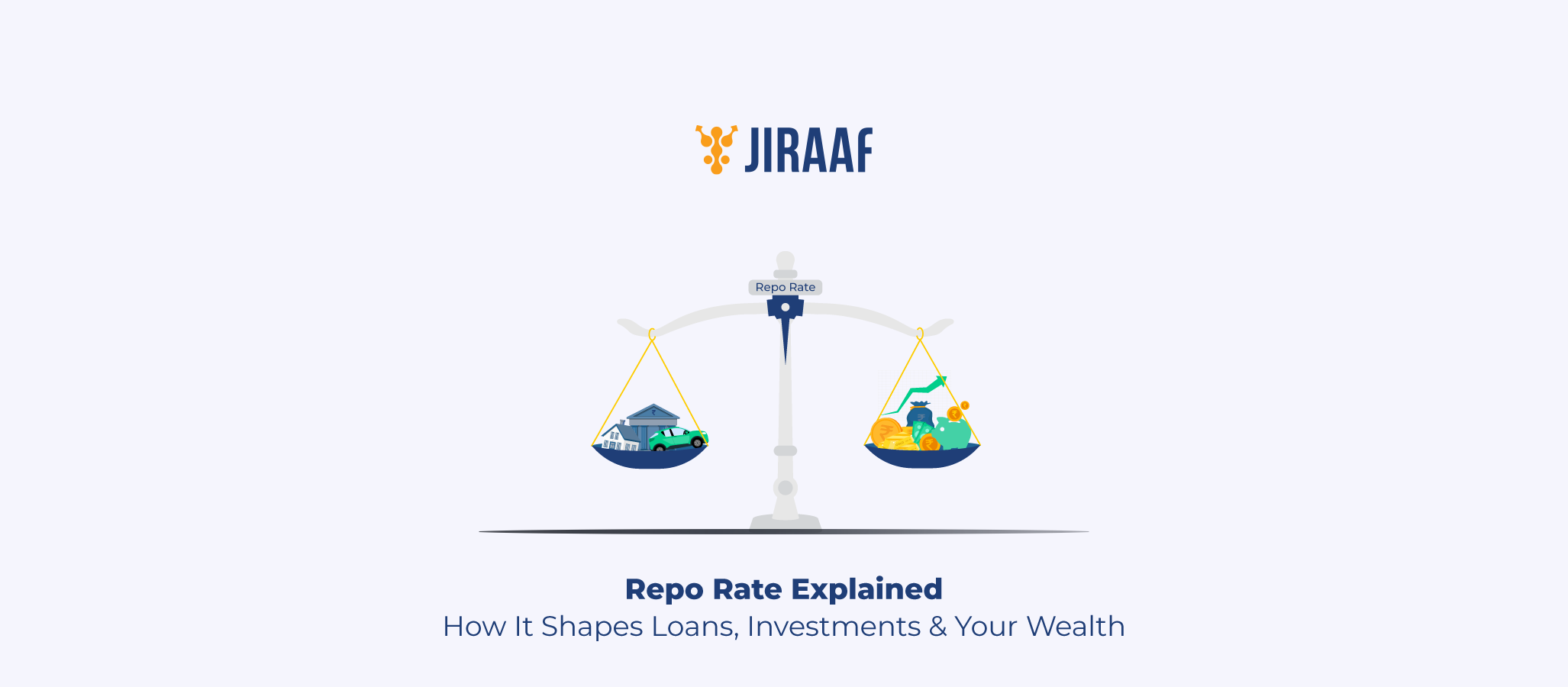If you’ve ever wondered why your loan EMIs fluctuate, why prices move up and down drastically in the market and what makes the interest rates on your savings change, let’s introduce you to repo rate.
One of the most powerful tools in a central bank’s arsenal, the repo rate shapes everything from inflation to investment flows in an economy. But how does the repo interest rate work? How does it have such a far-reaching influence? And more importantly, what does a shift in the repo rate in India mean for you?
In this article, we’ll learn how this one rate changes the way money moves in the economy, its historical trends, and its broader economic implications.
What is Repo Rate? How Does it Work?
Repo rate, or repurchase agreement rate, refers to the interest rate at which commercial banks borrow short-term funds from the RBI, using government securities as collateral.
In the broader context of banking, the repo rate is a key monetary policy tool the central bank uses to control inflation and liquidity. During high inflation, the RBI increases the repo rate to make borrowing costlier and slow down the money supply. When it needs to boost the economy, the RBI cuts the repo rate to make borrowing cheaper and increase liquidity in the market.
In financial markets, the repo rate directly impacts bond yields, foreign investments, and currency value. A higher rate raises bond yields, attracting foreign investors to Indian debt markets and strengthening the rupee. Conversely, a repo rate cut lowers yields, making bonds less attractive and potentially weakening the rupee. These shifts influence capital flows and market sentiment, affecting fixed-income and equity investments.
The reverse repo rate, on the other hand, is the interest rate at which banks lend their surplus funds to the RBI in exchange for government securities. A higher reverse repo rate encourages banks to deposit money instead of lending, reducing liquidity in the market.
So, by adjusting the repo rate, the RBI can influence inflation, GDP growth, and market sentiment.
How is the Repo Rate Decided in India?
In India, RBI’s Monetary Policy Committee (MPC) meets once every two months to assess key economic indicators such as inflation, GDP growth, liquidity conditions, and global market trends. Based on this evaluation, the MPC decides to raise, cut, or maintain the repo rate to achieve its monetary policy objectives.
Since the repo rate in India directly impacts loan rates, it affects the real estate, automobile, and MSME sectors the most.
Current Repo Rate in India
The current repo rate in India stands at 6.25%, following a 0.25% cut by the RBI in February 2025. The reverse repo rate remains unchanged at 3.35%.
This move suggests that the RBI is shifting toward an accommodative policy stance to support growth while maintaining inflation control.
Historical and Recent Repo Rate Trends in India
Let’s track the repo rate shifts in India over the past decade to gain insights into economic cycles, inflation control measures, and the RBI’s monetary policy decisions.
| Year | Repo Rate % | Key Economic Events & Policy Decisions |
| 2010-13 | 7.25% – 8.50% | RBI maintained high rates to curb inflationary pressures |
| 2014-18 | 6.00% – 6.75% | Gradual rate cuts supported economic expansion and credit growth |
| 2019 | 5.15% | RBI reduced rates to counter slowing GDP growth |
| 2020-21 | 4.00% | Historically the lowest repo rate; reduced to support the economy during COVID-19 |
| 2022-23 | 6.50% | Rapid hikes to combat rising inflation |
| 2024 | 6.50% | RBI held rates steady to balance inflation and growth |
| 2025 | 6.25% | First rate cut in 4 years, signaling a shift toward supporting economic growth |
Impact of Repo Rate on the Economy
A repo rate change triggers a chain reaction in financial markets, loan rates, corporate investments, and inflation expectations.
1. Inflation Control and Price Stability
Since the repo rate primarily functions to control inflation, when inflation runs high, the RBI increases the repo interest rate, making borrowing costlier. This reduces the money supply, curbs excess spending, and helps stabilize prices.
For instance, when the RBI increased the repo rate from 4.00% to 6.50% between 2022 and 2023 to counter inflation, even though this helped control the price spikes, it made credit expensive.
On the other hand, a repo rate cut (like in Feb-2025) increases liquidity and stimulates demand, making credit more affordable.
2. Economic Growth and Business Expansion
A high repo rate discourages borrowing, slowing business investments and economic expansion. Lower rates allow businesses to invest in capacity, hire more workers, and drive economic activity.
For instance, the 4.00% repo rate between 2020-21 played a crucial role in reviving the post-pandemic economy as it made borrowing cheaper for businesses.
In contrast, the tightening cycle of 2022–23 slowed capital investments, impacting real estate, manufacturing, and MSMEs.
With the repo rate in India now at 6.25%, businesses might find better access to capital, potentially reviving stalled projects and boosting employment.
3. Interest Rate Impact on Consumption
Changes in the repo rate affect loans, directly influencing consumers’ purchasing power. A high repo interest rate increases EMIs, discouraging borrowing, while a lower rate reduces loan costs, boosting demand.
For instance, in the housing sector, a rate cut generally leads to higher home sales as mortgage rates decrease. Consumer durable sales, such as automobiles and appliances, also rise when borrowing costs fall.
The February 2025 rate cut is expected to ease loan burdens, making it an opportune time for homebuyers and businesses to reconsider borrowing decisions.
4. Impact on Investments and Financial Markets
The repo interest rate affects bond yields, stock markets, and capital flows.
- Higher repo rates lead to rising bond yields and reduced equity market liquidity, making debt instruments more attractive to investors.
- Lower repo rates lead to falling bond yields and increased equity investments, leading to cheaper corporate borrowing.
Historically, rate cuts have triggered stock market rallies, as cheaper credit fuels business expansion and earnings growth.
5. Currency Value and Foreign Investment
The repo rate in banking also impacts the rupee’s value and foreign investor sentiment. A higher repo rate attracts foreign capital seeking better returns on Indian debt instruments, strengthening the rupee. Conversely, a lower rate can lead to capital outflows and currency depreciation.
For example, the 6.50% repo rate in 2023 attracted foreign investors to Indian government bonds, supporting rupee stability.
The 6.25% rate in 2025 could shift investor sentiment depending on global interest rate trends.
What is Affected by a Change in Repo Rate?
Let’s have a deeper look at what is affected by a repo rate change.
Impact of Repo Rate on Loans and EMIs
The most immediate and visible impact of a repo rate change is on loan interest rates and EMIs. Since banks borrow funds from the RBI repo rate window, any increase or decrease is quickly passed on to consumers, whether it’s through home loans, auto loans or MSME/ business loans, etc.
For example, for a ₹50 lakh home loan with a 20-year tenure, even a 0.25% decrease in the repo rate can lower EMIs by ₹800-₹1,000 per month.
However, banks may not always pass on the full benefit immediately, as they also factor in deposit rates and credit risks when adjusting lending rates.
Impact of Repo Rate on Businesses
For businesses, changes in the repo interest rate affect everything from capital investment to profitability.
Impact of Higher Repo Rates (2022-23 Cycle)
- Increased borrowing costs, slowing down expansion plans
- Higher working capital costs, reducing short-term liquidity
- Lower consumer demand, impacting sales and revenue
Impact of Lower Repo Rates (2025 Cut to 6.25%)
- Easier access to credit, improving cash flow management.
- Potential recovery in sectors like real estate, infrastructure, and capital goods.
- Better profit margins for businesses dependent on debt financing.
Impact of Repo Rate on Consumers
Consumers are directly affected by the repo rate in India, as it dictates borrowing affordability and disposable income.
Higher Repo Rate Scenarios
- Increased EMI burden, leading to budget constraints for families
- Reduced discretionary spending, affecting lifestyle purchases
- Slower demand for homes, cars, and consumer goods, impacting overall economic momentum
Lower Repo Rates Scenarios (2025 Cut to 6.25%)
- Lower EMI burdens, improving affordability for borrowers
- Higher consumer spending, boosting retail and automobile sales
- More investment in real estate as home loan rates decline
Sectoral Impact of Repo Rate Changes
| Sector | High Repo Rate Impact | Low Repo Rate Impact |
| Real Estate | Slowdown in property sales, high home loan EMIs | Increased home demand due to lower mortgage rates |
| Automobile | Higher car loan rates reduce demand | Lower financing costs boost car sales |
| MSMEs | Expensive credit restricts growth | More accessible loans encourage expansion |
| Stock Market | Reduced liquidity, cautious investor sentiment | Increased market participation, potential stock rallies |
| Banking | Higher lending rates, risk of NPA rise | Increased loan demand, stronger credit growth |
Frequently Asked Questions (FAQs)
What Is the Repo Rate in Simple Terms?
The repo rate is the interest rate at which commercial banks borrow money from the RBI by pledging government securities as collateral. It’s a key tool for controlling liquidity in the economy. A higher repo rate makes borrowing costlier, reducing money supply, while a lower rate makes credit cheaper, boosting liquidity. This impacts loan rates, business investments, and overall economic activity.
How Does the Repo Rate Affect Home Loans?
When the repo rate rises, banks increase lending rates, making home loans more expensive. This leads to higher EMIs and reduced affordability. Conversely, when the repo rate falls, as in February 2025 to 6.25%, banks lower home loan interest rates, reducing EMIs and boosting demand for housing. Borrowers with floating-rate loans are directly impacted, as their repayment costs fluctuate with repo rate changes.
Why Does the Central Bank Change the Repo Rate?
The RBI adjusts the repo rate to manage inflation, economic growth, and liquidity. A rate hike controls inflation by making credit expensive and slowing spending, while a rate cut boosts growth by encouraging borrowing and investment. Global market trends, currency stability, and domestic demand also influence rate decisions. The February 2025 rate cut to 6.25% was aimed at stimulating economic activity while keeping inflation in check.
What Is the Difference Between Repo Rate and Reverse Repo Rate?
The repo rate is what banks pay to borrow from the RBI, while the reverse repo rate is what they earn by depositing excess funds with the RBI. A higher reverse repo rate encourages banks to park surplus liquidity, reducing market money supply. The current repo rate in India is 6.25%, while the reverse repo rate remains at 3.35%, reflecting the RBI’s focus on economic growth.
How Does Repo Rate Impact Inflation?
A higher repo rate curbs inflation by making borrowing expensive, reducing spending and demand. This slows price growth but can restrict economic expansion. A lower repo rate boosts liquidity, increasing demand and potentially fueling inflation. The February 2025 rate cut to 6.25% indicates the RBI is balancing growth with inflation control, ensuring prices remain stable while encouraging business investments and consumer spending.
What Is the Current Repo Rate in India?
As of February 2025, the repo rate in India is 6.25%, following a 0.25% rate cut by the RBI. This shift signals a move toward supporting economic growth while maintaining inflation control. The reverse repo rate remains unchanged at 3.35%. Future rate adjustments will depend on inflation trends, global economic conditions, and domestic growth indicators, making it crucial for borrowers and investors to stay updated.
Discover fixed income investments with Jiraaf, a SEBI registered online bonds platform that educates and brings access to a wide array of bonds. Sign up today to explore diversified fixed income investment opportunities to support your goal-based wealth creation journey. Start investing!



